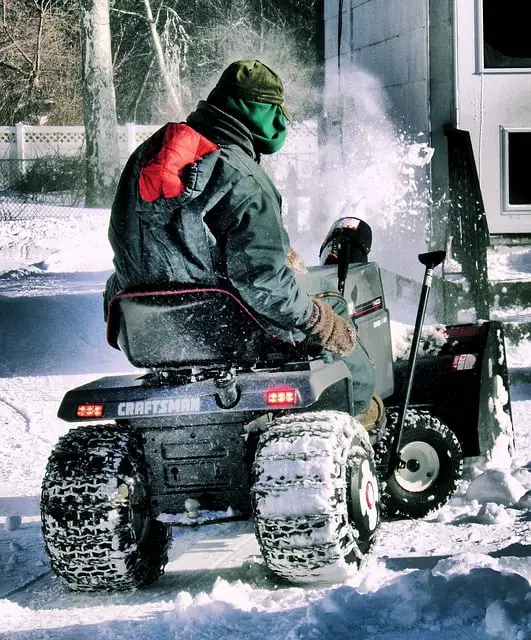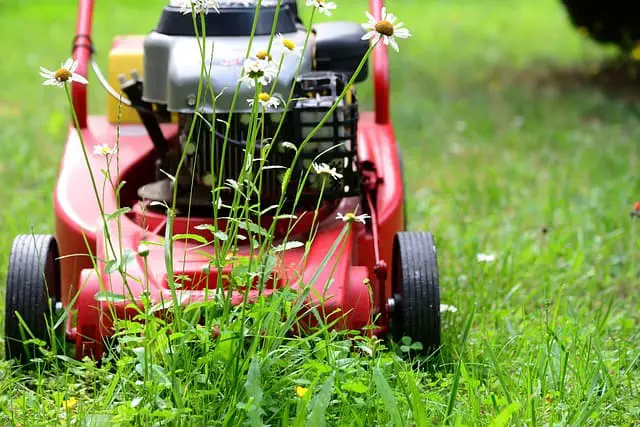A snow thrower is a machine that helps in removing snow. It works by picking up the snow in a single motion and then throwing it out as it moves along its path. In addition, it has a different mechanism and purpose than a snowblower.
How does a snow thrower work?
In a single-stage process, a snow thrower removes snow by simply throwing it on the sides and clearing the way. It has a low-rise auger that scoops up the snow and throws it away. It does this job without an impeller.
A horizontal spinning auger generates power to help pick up the snow and then creates the force needed to discharge snow from the chute.
The auger on a snow thrower is positioned low and is close to the ground. It is also protected by rubber. So, the machine works best on paved surfaces and cannot be used on gravel.
What Are the Parts to a Snow Thrower?
The overall design of a snow thrower is very similar to a lawnmower. There are four main parts that make it work:
- The motor: This can be powered by a battery, or with a cord that is plugged into an outlet.
- The auger: This is a cylinder-shaped shaft with a blade covering it. Its purpose is to dig in, break the snow and pass it to the chute.
- The clearing path: Each unit has an opening that allows a certain amount of snow to pass from it. The height and width of the opening is called the clearing path.
- The chute: Located right above the auger, the chute is a shaft through which the snow is thrown away.
What is a single-stage blower?
The technical term for snow thrower is actually a single-stage snowblower. Hence, they are referring to the same machine. This is important to know when you’re in the market, as ‘snow thrower’ is not a commonly used name for it.
Many people use the term snow thrower simply because it does not blow the snow like a two or three-stage blower would.
Are Single-stage snowblowers any good?
Single stage-snowblowers or snow throwers are compact machines that are quite easy to maneuver. They can be a good choice depending on their use and purpose. In fact, the small size and maneuverability make them quicker than two-stage blowers, if there is light or moderate snow.
They are also highly suitable for smaller garage driveways.
When should you use a snow thrower?
A snow thrower is perfect for removing light snow that is less than 13 inches thick. If you live in an area with light or moderate snowfall every year, you can rely on a snow thrower. So, you don’t always need to spend extra money on purchasing a snowblower.
Depending on the unit or model you buy, you can remove up to 22 inches of a wide section.
If you don’t wish to spend on repairs and want a low-maintenance machine, a snow thrower is a better option. These units are mostly powered by battery or electricity which means there is no hassle of oil or gas changes.
Is a snowblower different than a snow thrower?
It is more appropriate to refer to two-stage and three-stage snow blowers as ‘snow blowers’ as they actually blow away snow from the chute. The snow is also deposited at a much larger distance.
There are two stages to snow removal when you use a snowblower. First, the auger will scoop up the snow and direct it to the impeller. The second stage is blowing the snow out of the chute. This process is completed with the help of a powerful impeller that operates as a high-force fan.
Other differences between snowblower and snow thrower
Smaller size
Snowblowers are larger machines. As they are bigger, they are also more powerful and can even blow the snow up to 50 feet away. Plus, they are bulkier and heavier too.
Lower price
Single-stage snowblowers or snow throwers are more affordable of the two.
Type of snow
Snowblowers (two-stage) are good at clearing all types of snow whether it’s wet, dry, or heavy. In contrast, a snowthrower (single-stage) is mainly used for clearing dry and powdery snow.
Less effective
As snow throwers are single-stage machines, they are less effective and cannot clear paths that are too wide or deep. Any path deeper than 6″ will be too much for a snow thrower. Comparitively, a snowblower can clear paths as deep as 13″ to 21″.
What is the price of a snow thrower?
As with any machine, the price of snowthrowers varies according to the specs of the unit.
Generally, corded snow throwers start from a price of $100 for the most basic models. Larger corded snow thrower models with a powerful motor and features like headlights would cost around $300.
If you’re looking at battery-operated 40-volt models, you can expect a price of at least $250. Larger 100-volt units would cost up to $900.
Finally, a single-stage gas-powered snow thrower has a price range of $300 to $750, depending on its power and size.
An Overview of Snow Thrower
Pros
- They are ideal for light work
- Effective at removing snow that is close to the pavement
- Compact, portable and lightweight
- Budget-friendly solution
- No maintenance is required
- Very easy to store
- Gas or oil is not required to run it
Cons
- Less powerful compared to second-stage and third-stage blowers.
- A corded unit can be limited in its use
- Will not work on heavy, dense snow or wider paths
- Snow is not thrown as far away as a blower would
What is the best single-stage snowblower or snow thrower?
There is a huge variety of different models available in the market right now. According to SnowBlowersDirect, these are some of the best-selling models in 2021 with the highest ratings:
- Toro Power Clear 518 ZE
- Ariens Path-Pro 938032
- Briggs & Stratton 250CC Single Stage Snowblower
- Powersmart DB7005 21-inch 196CC
- Poulan Pro PR100 21-Inch
- Troy-BILT SQUALL 179CC 21-inch gas single-stage snowblower
Hi, I’m John Stephens, chief editor and writer for Totalgardener.com. I’ve been gardening and raising animals for over 15 years starting with a small backyard plot in Northern Virginia where I grew corn, potatoes, squash, and using a high mulch technique called the Ruth Stout Method. I also raised ducks and small mammals for meat and eggs in a movable pen similar to the ones used by Joel Salatin. I later moved to Colorado where I experimented with growing greens using aquaponics inside. I eventually added a microgreens setup and home sprouting operation. I’m excited to share everything I’ve learned plus more from the other local gardening and animal raising experts I know.



